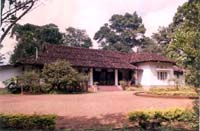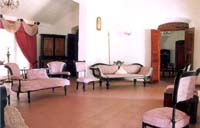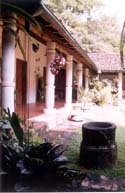It
is as old as Kandyan history or perhaps older.
It was home to more than eight generations of Elapathas. Situated
on the banks of the Walawe River, Elapatha Walauwa still stands as
it is used to more than 400 years ago.A bumpy and rocky road took us to the Walauwa, which stands
on high ground.
 Surrounded
by ancient trees, the first glance of the Walauwa gives the impression of
an ancient man surrounded by all his old companions.
Surrounded
by ancient trees, the first glance of the Walauwa gives the impression of
an ancient man surrounded by all his old companions.
However,
time has changed his face. The once lime-smooth floor has been replaced
with floor tiles.
The
old verandah, which used to surround the whole house, is now restricted to
the front with added bedrooms for the new generations to sleep in.
The
dignity of the ancient Elapatha Walauwa still remains with its simple but
elegant wood-worked door and window frames, its Sinhala ulu laid roof, its
antiques, huge barns and shady courtyards.
The
sitting area of the house has been altered over the years. “Most
of the furniture is scattered around the many generations with few
remaining at the Walauwa today,” the present owner of the
Walauwa, Samudra Elapatha said.There remain some antique furniture with photographs of
generations of Walauwa owners.

Many
attractions remain in the courtyard and one of them is the huge barn with
three parts to store different kinds of paddy.
The
barn is made out of Jak wood and is smoked to keep the insects out.
It stands on six stone pillars away from mice and rats.
Thus, the paddy lasts long and in good condition. A ladder is used
to reach the doors of the barn.
Another
attraction is the old acid bath. It was imported to
Sri Lanka nearly 250 years back containing acid for the budding
rubber industry at that time. The container, which is made out of
stone, is now used to nurture paddy seeds.

The
old lamp collection adds light to the antique collection. An array of
lamps used during various periods still hangs although unused. Many are
made out of metal while the comparatively new ones are of glass.
 Grindstones
and pestles, which are abandoned in the courtyard, too are from various
time periods.
Grindstones
and pestles, which are abandoned in the courtyard, too are from various
time periods.
The
once over-taxed and massive pestles lie to rest in the shade today and
only come to life during the harvest season. The pestle is designed to be
used by three or four people at one time. They walked around the pestle
singing folk songs ‘to make the work glide by’.
Farming
and mining instruments were stored under the barn as it was the rainy
season some lie scattered until their service is required.
Another
interesting collection is the hansi putu, found almost everywhere
in the Walauwa. These hansi putu have their own story to tell and one can
see the evolution of their carpentry style by comparing one with the
other.
The
house itself is a showpiece of evolution as there have been many changes
with time to which every lady of the house has added her own contribution.
The
Elapatha Walauwa is ancient, full of secrets, surprises and stories of
intrigue. It was standing
when the country was governed by a king, when a coup was organised to oust
the king, when the British took over. It has sheltered generations of
Elapathas, famous and infamous, including the famous Elapatha Mudliyar. It
saw so much and it heard so much and it could relate stories of love, fame
and agony if its walls could speak. If only they could…